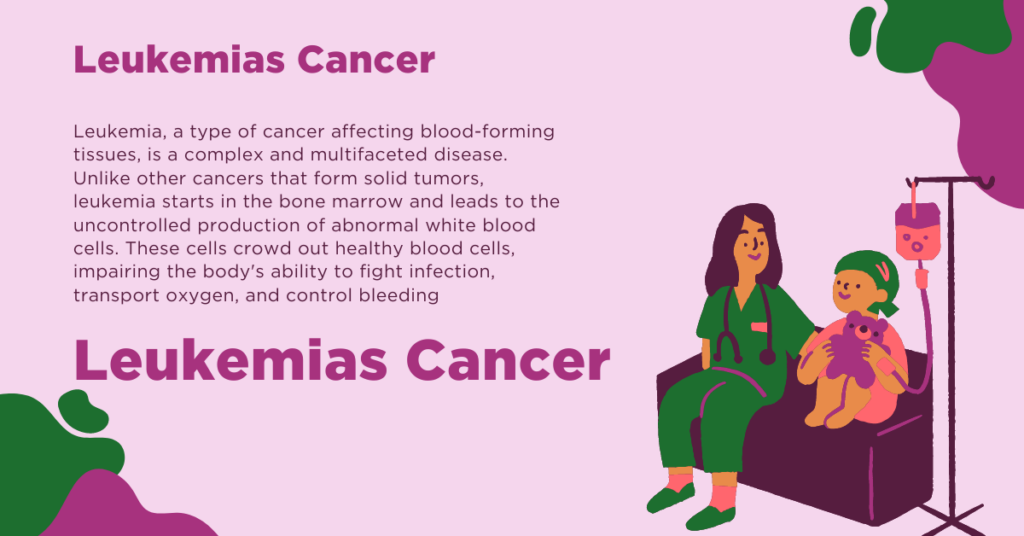Leukemia, a type of cancer affecting blood-forming tissues, is a complex and multifaceted disease. Unlike other cancers that form solid tumors, leukemia starts in the bone marrow and leads to the uncontrolled production of abnormal white blood cells. These cells crowd out healthy blood cells, impairing the body’s ability to fight infection, transport oxygen, and control bleeding.
Types of Leukemia
Leukemia is broadly categorized based on its progression speed (acute or chronic) and the type of blood cell it affects (lymphocytic or myeloid).
- Acute Lymphocytic Leukemia (ALL):
- Characteristics: Rapid progression, affects immature lymphocytes.
- Prevalence: Most common in children, but can occur in adults.
- Acute Myeloid Leukemia (AML):
- Characteristics: Rapid progression, affects myeloid cells.
- Prevalence: More common in adults but also found in children.
- Chronic Lymphocytic Leukemia (CLL):
- Characteristics: Slow progression, affects mature lymphocytes.
- Prevalence: Most common in adults over 55.
- Chronic Myeloid Leukemia (CML):
- Characteristics: Slow progression, affects myeloid cells.
- Prevalence: Mostly affects adults.
Causes and Risk Factors
The exact cause of leukemia remains unknown, but several risk factors have been identified:
- Genetic Mutations: Changes in the DNA of blood cells can lead to leukemia.
- Family History: A family history of leukemia can increase the risk.
- Radiation Exposure: High levels of radiation, such as from nuclear exposure or certain medical treatments, can increase the risk.
- Chemical Exposure: Prolonged exposure to chemicals like benzene can be a contributing factor.
- Smoking: Increases the risk of AML.
- Previous Cancer Treatments: Certain chemotherapy and radiation therapies can increase the risk of secondary leukemias.
Symptoms
Leukemia symptoms vary depending on the type but generally include:
- Fatigue: Due to anemia.
- Frequent Infections: Resulting from a lack of healthy white blood cells.
- Easy Bruising and Bleeding: Due to a shortage of platelets.
- Bone and Joint Pain: From the marrow being crowded with leukemia cells.
- Swollen Lymph Nodes: Especially in the neck and armpits.
- Unintended Weight Loss: Common in many cancers, including leukemia.
Diagnosis
Diagnosing leukemia typically involves:
- Blood Tests: To check for abnormal levels of white or red blood cells and platelets.
- Bone Marrow Biopsy: To identify leukemia cells in the marrow.
- Genetic Tests: To identify specific mutations or chromosomal changes.
Treatment
Treatment varies based on the type and stage of leukemia, the patient’s age, and overall health. Common treatments include:
- Chemotherapy: The primary treatment for most types of leukemia.
- Radiation Therapy: Used in conjunction with chemotherapy or for specific areas like the spleen or brain.
- Targeted Therapy: Drugs that specifically target leukemia cells without harming normal cells.
- **Bone Marrow Transplant


![Coughing up Phlegm: Causes, Symptoms, and Treatment [2024]](https://newstechblog.com/wp-content/uploads/2024/08/Coughing-up-Phlegm-Causes-Symptoms-and-Treatment-1024x614.jpg)
![10 SUPERFOODS TO LOWER BLOOD SUGAR LEVELS[2024]](https://newstechblog.com/wp-content/uploads/2024/08/10-SUPERFOODS-TO-LOWER-BLOOD-SUGAR-LEVELS-1024x614.jpg)